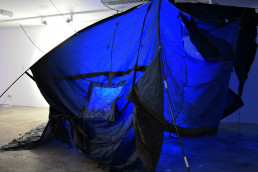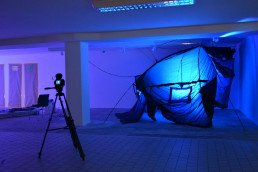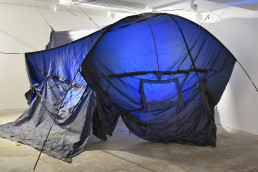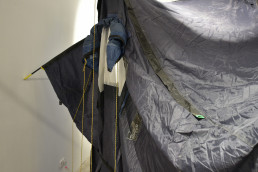Borderlands
Installation, 2021, Marco Melis
The project explores the hypothesis that no border (and no boundary and no limit) exists without a corresponding borderland, as minuscule as it might be. It does so by trying to display how borderlands are the natural homeland of many dialectic processes — also of artistic dialectic processes that can analogically and aesthetically (as opposed to directly and objectively, conceptually, and ultimately linguistically) exhibit fundamental aspects of our experience in general.
In particular, they can (analogically and aesthetically) display an indeterminate idea of totality that is the pre-condition of every determinate experience. Playing with the interstitial borderlands of the determinate, which tend to slip into the indeterminate, art can make us sense the unfathomable totality of our experience; make us feel, that is, like homo sapiens individuals standing on the borderland-everything, with no rules to follow except for the hypotheses, plans and possibilities we create ourself. So profound a freedom we can only stand for a moment, before going back behind borders.
Performance
Marco im Gespräch über „Borderlands“
Marco Melis (MA Sound Design)
Introduction
The project starts with the hypothesis that no border (and no boundary and no limit) exists without a corresponding borderland, as minuscule as it might be. Of course some specific borders, that is to say the limits of our experience, can never be crossed: the boundary between life and death, for instance, or between phenomenon and noumenon; therefore their borderlands can only be traversed halfway (specifically, the “inner” half). Incidentally, those two examples are connected with basic questions regarding life and consciousness respectively—what they are and what they can be, what their limits are—but assuming their boundaries as monolithically hard seems problematic, to say the least: terrestrial life, for example, has no clear edges, as we are experiencing in this moment of crisis provoked by an “organism at the edge of life”, a virus. In any case, even if we are not capable of fully experiencing those borders, we are nonetheless able to merely think their dialectic borderlands. More importantly, perhaps, we are also able to have experiences, i.e. so-called artistic experiences, that can analogically and aesthetically (as opposed to directly and objectively, conceptually, and ultimately linguistically) display fundamental aspects of our experience in general—namely an indeterminate idea of totality that is the pre-condition of every determinate experience. Playing with the interstitial borderlands of the determinate, which tend to slip into the indeterminate, art can make us sense the unfathomable totality of our experience. The latter, however, should by no means be conceived in metaphysical or mystical terms, but rather as the feeling that things can make sense to us, that we can grasp them and assign meaning to them, use them, navigate them, even build scientific knowledge sometimes, and all of that not only in relation to actual things, but also future, past or simply possible things, anticipating experience that might or might not happen.
Those ideas come from Emilio Garroni(1), one of the most important Italian philosophers of the XX Century. However the vastness, complexity and profound implications of the topics at hand deny a proper argumentation or even a clear slant in this presentation, especially given that the project will keep developing into a physical installation during 2021. I generally find very hard to write about recently-finished work, and almost impossible when it comes to work that doesn’t exist yet; therefore the only conclusive points I’ll make will be about a piece of music presented below, which is the only artistic outcome (as conclusive, autonomous work) of the project at this stage. The remainder of the presentation, from the next section on, should be approached as a collage of informal and problematic questions, impressions, thoughts that constitute a confuse “creative cloud” that one hopes to mould into a compelling form, without any aspiration of theoretical or historical accuracy.
Themes
The project revolves around three main topics that explore, through dialectic couples or processes, the relationship between border and borderland:
Outer borders as interfaces: transparency/distortion
Borders are always transparent, to some extent, as they allow what lies beyond them to be the other, defined from an external point of view. Such otherness, such distance, a condition of (presumed) objectivity, is never just empty space, but rather a borderland, a place of exchange and/or conflict, towards which the point of view is never fully external.
Inner borders as home: oppression/protection
Borders are plastic: they exert resistance against internal as well as external forces, oppressing or protecting respectively. They respond, react, organize, disrupt, manifest the fields in which they are immersed, be it the social fluid, the hidden movements of the unconscious, natural-growth processes, personal relationships or any other area in which complexity plays an important role.
Dialectic: a method
Both of those aspects imply dialectics between opposite poles, so that we might ask: can a border be infinitely thin, or there always need to be a width to it, no matter how minuscule? What is there within and what are borders made of? The width of borders imply dialectics, exchange and trade-off that model the emergent characteristics of both the outer and the inner faces. It’s a grey area: the borderland.
Anatolia: a land of borderlands
Music is an essential aspect of the project. Like all cultural phenomena, music is fluid and develops in dialogue (and often contrast) with other aspects of society. In March 2020, immediately before the first Covid-19 lockdown in Germany, I attended in Berlin a demonstration against violence on the migrants crossing the border between Turkey and Greece, the outer border of the European Union. I took the following picture while marching with my Turkish friend Şafak Velioğlu, a traditional musician who is passionate about instruments and musicology of the Middle East, the Balkans and the Caucasus. We started talking about music influences across borders.
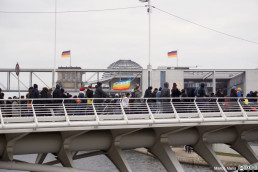
The Aegean Coast
Şafak told me about the complex history and shape of the Turkish-Greek border, a history dominated by minorities, displacements, mutual influences and shared music. Troy’s war in Homer’s poems takes place in the region, which is also the motherland of the first philosophers: presocratics Thales, Anximander and Anaximenes lived in Miletus, Heraclitus in Ephesus. It’s been speculated that the proximity with dissimilar eastern cultures stimulated the birth of philosophical thinking (although it’s been argued that their thinking shouldn’t be considered philosophy in the modern sense). The region subsequently underwent Persian, Macedonian and Roman domination, with Byzantium (later Constantinople and finally Istanbul) becoming the capital city of the Roman Empire, then of the Byzantine Empire, of the Ottoman Empire and finally of modern Turkey. Further South, the aegean coast of Anatolia is where one of the most exciting traditional Greek music styles comes from. The genre, called Rebetiko, carries along a great amount of Turkish music influences and instruments. Anyone familiar with Tarantino’s Pulp Fiction probably remembers the closing song, Misirlou: the title means Egyptian girl and it’s a declaration of love for an Arab girl, a sensual passion that crosses ethnic, cultural and religious borders. The version below is sung in the dialect of Smyrna (Izmir today), one of the epicentres of Rebetiko, a city a little over 100 km from Miletus that we will mention again.
Rebetiko music is essentially a syncretic genre and really a bridge between Western and Eastern traditions. Moreover, many Rebetiko songs exist in both Greek and Turkish versions, which further shows the cultural permeability that can take place in borderland areas: a phenomenon we can also observe in other regions where cultural exchanges and contaminations were fervid.
The Pontus
The history of the Anatolian plateau, borderland between Europe and Asia, has always been turbulent. The region of Pontus, in the north, had been inhabited by Greeks since the 8th century BC, almost 3000 years ago, subsequently undergoing the “usual” dominations: Roman (under which they converted to christianity and eventually orthodoxy), Byzantine and finally Ottoman. Pontic Greeks were allowed to keep their traditions under the Ottoman rule (a common practice of the extensive empires of that era), preserving their religion, their greek language and their culture, including music.
Around the time of World War I, however, the Ottomans (and shortly after the newborn Republic of Turkey) pursued operations of “ethnic cleansing” throughout and outside Turkey, resulting in the Armenian, Greek and Assyrian genocides. Most of the Pontic Greeks that were not killed had to flee from the region they had lived in for millennia, while many other died during the journey to Greece. Additionally, in 1922, between 10.000 and 100.000 Greeks and Armenians died in the great fire of Smyrna (which conversely spared Jews and Muslim quarters). Liability is still a matter of controversy: some historian say the Turkish military, who had just captured the city, started the fire, while some blame Greeks and Armenians themselves. Incidentally, the ensuing Greek diaspora is one of the causes of the spread of Rebetiko music all over the world.
Previously, however, Pontic Greeks and their Turkish neighbours used to share musical traditions, with pieces occurring both in Greek and Turkish language; fascinatingly, some old songs even have mixed language lyrics: they are sung by both ethnic groups, although they respectively don’t understand the words in the other language. This fact clearly speaks of a shared cultural sphere. But the tragic reality is that Pontic Greek culture is almost dead: some Pontic Greeks moved to Greece, a fairly similar culture that is slowly assimilating them, diluting their uniqueness, while some other moved to the Caucasus, especially Armenia, a country whose people underwent a similar tragic fate in Turkey.

Armenia and Azerbaijan
While Azerbaijan is closely related to Turkey from a linguistic, religious, political and economical point of view, Armenians constitute a quite isolated community with its own language, its own alphabet and its own declension of christianity, the Armenian Apostolic Church. A large part of the country borders Azerbaijan both to the East and the West (the Azeri State includes an exclave that wraps around Armenia) with the two countries having been in a conflictual relationship for a long time, with no peaceful solution in sight, it seems. I have the impression that the region has always been at the border of “mainstream” history: just outside Mesopotamia and its great empires, at the edge of the Persian, Roman, Byzantine and Ottoman Empires, crushed between Turkey and Soviet Union. The latter actually encompassed both Armenia and Azerbaijan and it’s involved in the onset of the Nagorno-Karabakh conflict, despite eventually managing to “freeze” it. The geopolitical details are beyond my knowledge and the scope of this presentation, but certainly the current borders depict a rather complex scenario: it is possible, for instance, to draw a straight line of around 100 km on which one would cross Azerbaijan, Armenia, Azerbaijan, Armenia-controlled Nagorno-Karabakh and again Azerbaijan. Of course, at a smaller scale one would cross many more such “borders”: to the point in which, in urban areas, one household would be Armenian and the next one Azeri. My point is that such mixed patterns speak of a time in which peaceful coexistence, cooperation, friendly relationships etc. must have been in place (just like between Palestinians and Jews before the British Mandate). A hint in that direction again comes from music.
The Armenian national instrument is the duduk, a double reed woodwind instrument made of apricot wood. It produces a rich yet intimate sound and it’s usually played by a soloist accompanied by a second (and sometimes a third) duduk that only plays drone notes. A drone is a steady note, usually in the low register, that serves as background, providing a harmonic framework to the soloist (the same principle applies to the drone pipe(s) of a bagpipe). The following piece by Djivan Gasparyan, one of the most famous Armenian duduk players, is a good example of the contrast between the extreme expressivity of the soloist and the steadiness of the drone sound. To me, the music provokes an association between the drone and the naked, barren landscape of the Armenian Highlands. Focusing on the drone alone makes me speculate on how the land would look like without any trace of human civilization—a land that is in facts impassive to human struggles and conflicts, just like the drone seems to be impassive to the virtuosic laments of the leading duduk. And yet, the latter wouldn’t be the same without the former, just like earth and geography support but also deeply shape culture and history.
The duduk is played in Azerbaijan too and, despite being called balaban, it’s used to play the same music. The following video is an interview with my friend Şafak Velioğlu in which we discuss those and some other topics. In relation to the Caucasian regions, he often refers to the division of labour, one based on ethnicity: a (spontaneous) organization in which different ethnic groups specialize in different productive activities. Such a system requires mutual recognition and respect among different cultures: a clear distinction of identities, rituals, etc. but simultaneously the emergence of a “pre-public” sphere, a sphere of exchange, a market. Music, among many other things, reacts to such dynamics, bears traces of those interrelations and records them in its traditions.
A piece of Polygonal music
Polygonal is the title of a piece of music that currently is the main artistic outcome of the project. It is an abstract piece that doesn’t rely on specific traditional languages, although traditional elements do appear. As a matter of fact, the form of the composition falls into a category that has no name, and probably doesn’t amount to a “tradition”, but has been used by many composers.
The first that comes to mind is Rebecca Saunders, a superb British composer living and working in Berlin, and I’d like to use her words to describe her idea of “sonic sculptures”. From the program notes of her concerto “Still”:
Fragments, each time slightly varied, gradually create a single image. Imprints reiterated and projected into time and space. Like a giant mobile seen from many perspectives, that in itself remains untouched. And light changes, the focus, and the position from which perceived, is altered, as is nearness and distance to the object – a manifest complex protraction of the one single thing.
Still, as in stasis, explores two starkly contrasting states, in a fragile state of equilibrium.
Still refers to the framing of sound with silence, of „stillness“ imagined – silence being an endless potential, waiting to be revealed and made audible. The act of composing being to unveil, make visible. Pulling gently on the fragile thread of sound, drawing out from the depths of imagined silence; or alternatively, sound erupting from the stasis of relative silence.
I read in Rebecca’s words some fundamental aspects of my own piece. The “giant mobile” glimpsed from different perspectives is never fully reached, at least not in a stable and tranquil way: the tension towards it is what drives the piece forward. The point of view progresses through a series of movements along the sides of an enclosing polygon; each segment is followed and preceded by rests, the corners of the polygon. The substance of the music is the dialectic relationship between the moving subject and the centre, a dialectics often driven by contrast and tension: perhaps the whole piece can be imagined as a series of (impossible) attempts at crossing the borderland that divides the listener and “the one single thing”.
As a final note, the fixed harmonic foundation of the piece has been influenced by the drones that appear in Armenian and Azeri music. Furthermore, many of the timbres are the result of my own effort to design sounds freely inspired by the duduk’s timbre.
The audio track should be listened to on a full-range, flat-response, stereo audio system.
Installation
The original idea for the physical exhibition was an installation with the intent of embodying the three basic topics described in the beginning into a spacial structure that the audience could physically walk. The structure should be divided into two main sections.
The first one consists of a passage, delimited on the left and right side by curtains, which shrinks as the participants move forward; along the way, semi-transparent curtains are set transversely. Those two spacial directions (longitudinal and transversal), are connected respectively with the first and the second topic. Specifically, the idea of borders as interfaces is embodied and elaborated through the use of crossing “doors”, separating what lays ahead from what is behind; along the way, the second spatial dimension (defined by the left and right “walls”) becomes more and more prominent, with an emphasis on the oppressive element of the second topic (inner borders as home: oppression/protection). At the same time, however, the longitudinal boundaries provide separation and protection from the external environment of the gallery, creating the space in which the installation exists — a space of suspension and imagination. The threshold between the first and the second section is the source of a sound composition for speakers. The medium of sound itself, as propagating waves absorbed by the “doors”, is used as a means to explore the physical characteristics of the installation and its materials. At this point

the structure converges into a narrow passage that separates the second from the first section: beyond, the side elements begin to open up again, giving space to a new zone. Here we find a camping tent, while in the back an array of ventilators moves the air towards the visitor. The camping tent may have some rips, while the ground could be covered with artificial grass. In this section, the “home” topic is embodied by the air that allows us to survive, by a fictional representation of nature (wind and grass) and by the idea of protection evoked by the tent. The airflow is also in dialogue with the sounds of the first section. The third point — dialectics as a method — pervades the entire installation and is connected with the idea of providing a free space for the visitor to question, reflect and create, by inhabiting the borderland between props and imaginative worlds.
(1) One of the major works of the Italian philosopher, an extremely dense, profound and comprehensive book:
Garroni, Emilio. 1991. Sinn und Paradox: die Ästhetik, keine Fachphilosophie. Studia philosophica et historica, Bd. 15. Frankfurt am Main: P. Lang.
